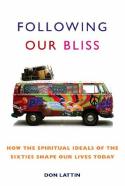Issue Date: December 12, 2003
Author traces today's religious trends to past decade's innovations Reviewed by Melissa Jones Most baby boomers have special memories of the 1960s. I was in grade school then, and about 10 years behind where my heart wanted to be -- in the streets protesting the war and in the parks sharing flower power with the hippies. The spirit of those years spread across the United States. It even reached my small Arizona town, where I tried to wear a black armband to school to protest the Vietnam War. My mother made me take it off before the bus came. Mom did let me buy a peace sign pin that I wore frequently. I still have it. I also still have some other gifts of the ’60s -- a sense of social justice, a mistrust of authority and hierarchy, and a longing for a direct and personal experience of the divine. In his book Following our Bliss, longtime San Francisco Chronicle religion reporter Don Lattin draws from his years of experience as an observer of spiritual ferment in the highly charged California religious climate. Lattin asserts that the spiritual explorations of the ’60s fundamentally altered America’s mainstream Protestant, Catholic and Jewish institutions, and he augments that claim with material from solid academic research. He ties ’60s innovations to present-day trends such as New Age religion, the Christian rock movement and the questioning of sexual and authoritarian traditions taking place among the Catholic laity and clergy today. Lattin maintains that the ’60s led many to move beyond the “thou shalt nots” of Christianity, Judaism and Islam, while still embracing the religious wisdom and insights provided through these religions. He also examines that era’s exodus of many mainstream believers to Eastern religions and the human potential movement. In analyzing the reasons for these changes, Lattin rightly focuses on the human desire for a direct experience of the sacred. He said, “We didn’t want to believe it, we wanted to feel it.” Lattin defines the spiritual era of the ’60s as a state of mind that began with John F. Kennedy’s inaugural speech, which set the stage for a generation of idealism and social commitment. Kennedy’s mandate, “Ask not what your country can do for you, ask what you can do for your country,” combined with the feelings of hope and possibility inspired by Vatican II, resulted in an age of social consciousness unequaled to this day. According to Lattin, the spirituality of the ’60s extended beyond the actual decade and into the ’70s, until it came to a crashing end with the 1978 murder and mass suicide at Jim Jones’ People’s Temple. This event soured the world on religious experimentation, cults and communes. The book is wide-ranging, covering religious movements such as the Moonies, the Hare Krishnas and the interest in Eastern spirituality. It also discusses human potential movements and communes, such as EST, Esalen and The Farm. In an interesting sub-study, Lattin also talked to some individuals who were raised in communes and ashrams, as well as to some who suffered abuse under the Moonies and Hare Krishnas. Many children of the ’60s found that their parents were more interested in changing the world than in changing diapers. As one man who was raised at Esalen said, “I felt my mother put the interest of society as a whole over me and the family.” In analyzing the positives and negatives of ’60s spirituality, Lattin notes that it was liberating, but it could also be divisive. Resulting feminism and gay liberation movements caused an opening up of religious dialogue about gender and sexuality. However, as the recent ordination of a homosexual bishop in the Episcopal church has shown, such liberation can divide a group into those labeled “traditional” and those seen as “tolerant.” Still, Lattin said, “Today’s search for an ethical, sex-positive spirituality is one of the most powerful -- and still unfolding -- legacies of the ’60s.” The anti-authoritarian slant of the ’60s also left a deep mistrust of religious hierarchies. Continuing conflicts in the Catholic church today about birth control, homosexuality, and the role of women and laity also can be traced back to the “question authority” spirit of that time. One wonders if the headlines about the Catholic church’s child sex abuse and payoff scandals would have been possible before the ’60s, when priests, bishops and cardinals were unquestioned in their authority and power. In his analysis, Lattin states, “Perhaps the miracle of the ’60s is that we truly believed we could save the world and transform ourselves. Some of us still believe that, and the world still needs changing.” For those old enough to remember the ’60s, this is a book that will pique memories, and perhaps a sense of loss. For those too young to revel in nostalgia, it is a primer for Gen X that explains and describes the ’60s foundations of many religious trends and movements at work today. Melissa Jones, a frequent contributor to NCR, writes from Littleton, Colo. National Catholic Reporter, December 12, 2003 |
